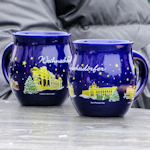
One of the picture-postcard scenes of Vienna in the Advent period is a group of friends standing round a tall table at an open-air market, each clutching a mug of Christmas punch (German: Weihnachtspunsch).
- Hot alcoholic beverage served in numerous varieties
- Non-alcoholic versions also available
- A genuine Viennese Christmas experience
- Each market usually has its own collectible mug
- Book a concert experience* for your Vienna trip
- See also:
Weihnachtspunsch

(Market booth selling Weihnachtspunsch)
Any visit to one of Vienna’s famous Christmas markets is incomplete without the obligatory draft of liquid yuletide cheer and perhaps some roast chestnuts to help any alcohol settle.
Many locals meet after work to wind down while wrapped in wreathes of steam from mugs of Weihnachtspunsch. (The Christmas markets are no pretend event put on just for tourists, but an integral part of the seasonal tapestry of Viennese life.)
You may also find pop-up booths in, for example, pedestrianised areas that also sell the drink during the Christmas season.
What’s in it?
The punch you get at the Christmas markets is served hot and often rather sweet.
Quite what’s in the drink depends on who you talk to. I’ve yet to work it out, frankly, despite considerable research effort.
The two most common alternatives behind the mystery appear to be:
- A combination of tea, spices, sugar and spirits (particularly rum and/or brandy)
- A version of Glühwein (mulled wine). You also find Glühwein itself sold from the same booths, as in the photo above
If you prefer to steer clear of alcohol, but still want the Weihnachtspunsch experience, simply try the non-alcoholic version. The latter may be labelled as Kinderpunsch (literally “Children’s Punch”) or alkoholfrei (“alcohol free”).
In recent years, the variety of Weihnachtspunsch flavours seems to have exploded.
When I first arrived in Vienna, you essentially had one option: punch. Now we have all sorts of mostly fruit-themed alternatives, from the obvious (orange, raspberry, etc.) to the exotic (e.g. mango, cranberry & elderflower).
To learn more about the vernacular of punch and other delights at the markets, see this glossary.
The mug tradition

(Mugs from a previous market at Belvedere)
When you pay for a mug of punch, the price is higher than advertised on the side of the market booth. Relax: the money you hand over includes a deposit for the mug itself, which you get back when (if) you return it.
Expect this deposit to be somewhere between €4 and €5 at most markets in 2024.
The Christkindlmarkt on the Rathausplatz and many other Christmas markets have their own unique mug design.
The motifs usually change each year, so people often treat the mugs as collectibles and keep them for themselves. Doing so is a perfectly acceptable practice (but also why they charge the deposit).
These days, many markets even sell the mugs separately at their information stand or a dedicated mug booth.